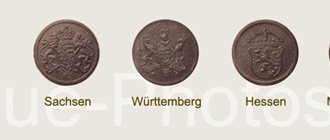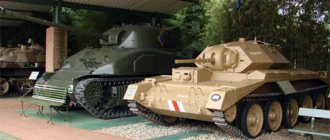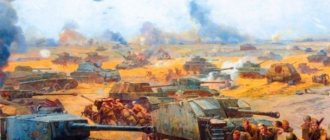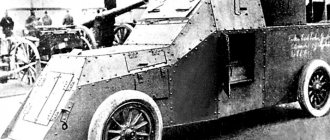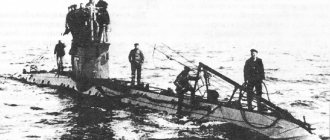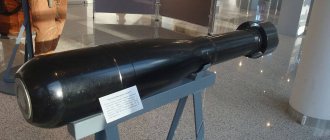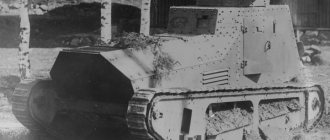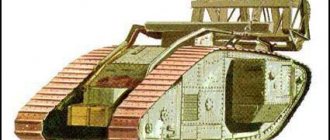Germany became the third country to use its tanks on the fields of the First World War. As in France and England, the German generals were against the creation of tanks. Captured by stereotypes that only a multimillion-strong army can win a war, one of the generals declared: “No “bad” piece of hardware can defeat the healthy spirit of a German soldier.” Probably, based on precisely these principles, they began to use chemical weapons.
Having a well-developed steel, automobile and military industry, the country's designers simply could not help but try to create tank prototypes, and the presence of several patents is proof of this. In 1912, the Australian railway worker G. Burshtyn received a patent for the manufacture of a fully combat-ready armored tracked vehicle, the Motorgeshute. Some time later, German historians will remember the patented project of G. Burshtyn as the progenitor of all tanks. Another often later recalled “land cruiser” project was presented by engineer B. Gebel in 1915 - a 550-ton vehicle bristling with tires and cannons on rotating spheres. Among the real prototypes, we can highlight an 18-ton armored carriage based on a four-track truck designed by G. Bremen. A full-size model was presented in 1916.
Perhaps due to the not entirely successful use of tanks by the British, the German command was in no hurry to give an order for the development of a full-fledged tank. Only in the summer of 1917 did the first A7V vehicles begin to enter service with the troops. At first, the English name “tank” was used, then “panzerwagen”, “kampfwagen”, “panzerkraftwagen” appeared, and on September 22, 1918 the term “sturmpanzerwagen” was officially approved.
The LKI 1918 light tank was built under the strong influence of the light English Whippet tanks. Later a sequel appeared - modification LKII. They were working on an interesting project - a combat vehicle on a tracked propulsion system with a wide transverse vertical shield mounted on the stern; such a “wall” was supposed to serve as protection for infantry from bullets and shrapnel. The order for production was received in the summer of 1918, but only a prototype was built before the end of the war.
Germany was also involved in the design of heavy tanks. Before the end of the war, she managed to build two three-turreted Colossal tanks, weighing 148 tons each.
Models of German Blitzkrieg tanks
The Treaty of Versailles obliged Germany to stop all developments in the field of tank building, and to transfer all tanks, including unfinished prototypes, into the hands of the winners. Officially, that's how it was. But the German leadership could not come to terms with the loss in the First World War and had already begun to understand the importance of tanks in modern warfare. Therefore, already in 1919, secret development of tanks and their units began under the guise of agricultural implements. The transmissions were supposedly designed for heavy tracked trucks, and the engines for tractors. Germany built its first post-war tanks in foreign factories controlled by German monopolies, for example in Sweden. The tank itself was assembled abroad, and transmissions and engines were supplied from Germany. Secret testing of the equipment took place in the then friendly USSR.
There is a misconception that the violation of the Versailles Treaty began with Hitler coming to power in 1934, and before that development took place exclusively within a peaceful framework. And no one is embarrassed by the fact that the “small tractor” and “large tractor,” released in great secrecy in 1927, had armor and a turret with a 37mm cannon in the “small tractor” and a 75mm cannon in the turret of the “large tractor.”
With the advent of Hitler, mass production of tanks began, but it was stopped by order of the same Hitler until the adoption of the strategic doctrine of Nazi Germany. The tanks were to be designed exclusively for the theory of “lightning” war.
Heinz Guderian
One of its founders was Heinz Guderian. The point was to rethink the entire concept of warfare. Prior to this, priority was given to infantry and cavalry, but here the main role was given to tank formations in close cooperation with aviation and aviation troops.
Blitzkrieg scheme
Tank wedges, coordinated by aviation, must break through the enemy’s defenses at high speeds and cut their army into parts isolated from each other, which will have to be eliminated by other ground units following the tank formations. Moving deep into enemy territory, tank units must capture vital centers until a serious defense of the latter is organized. Since the success of the operation depended on the lightning speed of the strike, reserves as such were not provided, and a special role was given to the training of personnel and the development of interactions between different units and branches of the military.
Before World War II, three tanks of different types were designed and put into service in Germany. In 1934 - light PzKpfw-I with exclusively machine gun armament, in 1936 - light PzKpfw-II, and in 1937 medium PzKpfw-III and PzKpfw-IV. According to the accepted concept, they all had a relatively high speed, but at the same time they had high ground pressure and poor track traction, especially in sub-zero weather. That is, the tanks were developed to wage a “mainline war” in the warm season.
PzKpfw I
PzKpfw-II
Pz.Kpfw. III Ausf. J
In fact, they were assigned the role of destroyers and demoralizers of enemy manpower, therefore, when choosing weapons, preference was given to rate of fire rather than caliber. Even the medium PzKpfw-IV was designed to support lightly armed tanks, its 75mm short-barreled gun was supposed to, by firing high-explosive fragmentation grenades, compensate for the insufficient power of light tank shells. As a result, the markings: tanks with purely machine gun armament received the index “I” in their names, those armed with a 20mm gun received “II”, those with a 37-50mm gun received “III” and a 75 mm gun led to the appearance of the index “IV” in their names. The command tanks did not have any weapons; a wooden barrel was attached to them for camouflage.
There were no heavy tanks in Germany before the start of the war. For propaganda purposes, in 1935, 5 multi-turreted, as advertised, heavy tanks were produced. In fact, their mass turned out to be only 24 tons. The fight against enemy tanks was assigned to self-propelled guns and tank destroyers.
Refutation of the magnetic theory
The main theory says: “German specialists developed a new way to destroy enemy armored vehicles and decided to act proactively. Protect your armored forces from such weapons." Without going into details, it looks plausible. There are just a lot of BUTs:
The Sticky Bomb, known as the ST grenade, Anti-Tank No. 74, was developed in 1940. I used a regular sticky coating and stuck to the surface of armored vehicles without “magnetic devices.” The usual improvement of a projectile to a cone-shaped one for a “cumulative effect” solves the issue with magnets. The use of the bomb showed that the infantry was not eager to come out of cover and use grenades. To put it mildly, they were “cowards.” There was no talk about “running up” to the technology in close proximity.
The M1 or "Bazooka" was developed in 1942 and was a fairly effective means of destroying armored vehicles at short range and in urban battles. It is on its basis that the Germans develop their Panzerfausts and Panzershreks in the summer of 1943
Shielding of armored vehicles. Defenses against small artillery and weapons reached their peak by 1943 . It was at this time that equipment with additional external protection appeared, which effectively combats “magnetic mines”, preventing them from being attached directly to the body
The height of the Royal Tiger is 3 meters and it is completely covered with a protective layer. It is very difficult to imagine that an infantryman will run out of a trench (ruins) and try to climb onto a tank in order to attach a mine to the turret.
There are much more facts, but those listed are weighty enough that it would not occur to German scientists to develop protection against magnetic mines when there are more weighty and pressing questions.
Names of German tanks
All tanks that entered service with the German army received the letter abbreviation PzKpfw (short for panzerkraftwagen - armored fighting vehicle) and a serial number. The name of the modification consisted of letters of the German alphabet and the abbreviated word ausfuhrung - execution, model, option.
In addition, there was another designation system for all mobile assets of the army. According to it, most tanks and self-propelled guns, but not all, received a designation consisting of the abbreviation Sd Kfz (abbreviated from Sonderkraftfahrzeug - special purpose vehicle) and a serial number. For example: the full name of the German T-IIa tank sounded like Pz.Kpfw.II Ausf.a Sd Kfz 121; for convenience, the army used the designation Pz IIa.
Due to the abundance of types and classes of self-propelled guns, it is very difficult to bring their designations to a single denominator. Anti-tank guns, anti-aircraft guns and self-propelled howitzers had their own designation system, and assault guns had their own. In addition, the official name, along with the artillery system used, included information about the base tank chassis. As a result, the name Sturmgeschutz III designated an assault gun based on the Pz IIa tank, and Panzerjager I was a tank destroyer based on the Pz I. The full name of the latter sounded like 4.7 cm Pak (t) PzKpfw I Ausf B, with the decoding: Czech-made anti-tank gun based on a tank. It should be noted that the caliber in the German troops was measured in centimeters. Captured tanks received the designation PzKpfw and a serial number, starting with the number “700” (in addition to the Czech ones, they were mass produced). To indicate the country of manufacture, the corresponding letter was placed in parentheses after the number: t-Czech, r-Russian f-French, e-English.
Experimental tank designs were designated with the letters VK (short for Versuchskonstruktion - experimental design) with a four-digit number, where the first two digits indicated the weight of the vehicle, and the last two digits indicated the serial number of the project.
My personal doubts and the reason for studying the issue
For quite a long time I did not attach any importance to the issue. If they say so, that means it is so. Until, on an excursion to the museum, one of the technicians servicing the German giants expressed “His point of view” with specific examples. He took an ordinary magnet and stuck it to the zimmerit coating. And I wondered - how does it work? Moreover, he showed that the protective coating was applied to the track space, where, even if desired, a magnetic mine would not fit; on horizontal surfaces, where magnets are not needed at all, the mine would stand under its own weight, and so on. That is, the entire hull was covered with the composition, priceless resources and money were spent on protection where the mine would not be used under any circumstances. A striking example. A protective casing around the machine gun... can you imagine an infantryman running out in front of a tank and walking up to the machine gun to plant a mine? You have to be very brave to do something like that.
German tanks of World War II
Before the attack on the USSR, German tanks, replenished with Czech T-38(t) and T-35(t), satisfied their leadership in everything; they successfully conquered half of Europe. But the first clashes with the Red Army showed how German tanks were inferior in quality to Soviet ones. And the point is not that they previously came across “worse” tanks; in military operations on the territory of other countries they tried to avoid tank battles, successfully using tactical maneuvers and artillery with aircraft, and in the war with the USSR they had to engage in oncoming tank battles on the move , unlike the same Africa. But it cannot be said that the Wehrmacht tank forces were bad, thanks to the excellent quality of the transmission and engine, excellent optics and, above all, highly qualified personnel; according to statistics, German tanks went on the attack 11 times, while Soviet tanks only 3 (!).
During World War II, Germany constantly modified its existing tanks, mainly by increasing armor and armament. During this period, it put into production only two models: in 1943. PzKpfw V "Panther" and "PzKpfw" VI "Tiger" appeared in 1944. The Tiger developed into the "King Tiger" (PzKpfw VI Ausf.B "Tiger II").
In addition to the classic ones, 2,650 radio-controlled Goliath tanks were produced before the end of the war. Such vehicles were used to lay roads in minefields and destroy fortifications. According to the plan, a Goliath unit was to be included in each Tiger battalion. But as G. Guderian later complained, for various reasons there were always not enough of them.
Another destroyer of fortified areas should have been the 188th tank PzKpfw VIII “Maus” (Mouse), which was built in a single copy before 1945.
Pzkpfw VIII Maus
Particular attention was paid to the production of self-propelled guns, and as the Wehrmacht went on the defensive, it constantly increased. Among the anti-tank ones, the most famous are “Ferdinand” (later renamed “Elephant”), “Nashorn”, “Hummel”. I would like to highlight the high-power self-propelled guns on the Karl tracked base. launched 6 such mortars, firing shells weighing 2200 kg.
In total, during the period 1939-1945, Germany produced a little more than 50,000 tanks and self-propelled guns of all modifications.
Pz.Kpfw.VI Tiger III (Tiger 3)
Don't be fooled by the name, this is the name for a production car, according to the German classification. Among armored vehicle history buffs, it is better known as the E-75 .
As you can see, the Americans captured this particular vehicle and are conducting a detailed inspection of it. Apparently the year is 1946-47 and World War II is still not over.
Modern tanks of Germany
The revival of the German tank industry began in 1956 with the initiative of NATO, whose leaders saw in the modern and well-armed German army a force that could be opposed to the ever-increasing influence of the USSR in Europe. At the initial stage, Germany was engaged in the repair and modernization of the M47 and M48 supplied by the Americans, and in 1966. The army adopted the Leopard-1 main battle tank of its own production. After 1980, one of the best world tanks of the 3rd generation, Leopard-2, was supplied to the troops.
More material on the topic
- M4 Sherman
- New deadly tank T90MS
E-60 Sabelzahntiger (Saber-toothed tiger)
This vehicle, apparently, became the first German MBT . It should replace the two machines described above at once in the early 50s.
As you can see, the turret of the tank is made in the style of the E-50 ausf M , known from the game World of Tanks. Well, the body is borrowed from the already mentioned alternative E-79.
The true purpose of Zimmerit
Since this is my personal opinion, I will express it specifically. Zimmerit is a lubricant used to increase the ricocheting properties of armor. Under severe impact loads, it reduces friction between the armor and the projectile, which increases survivability. The illustration below clearly shows that not every shell penetrated or weakened armor.
